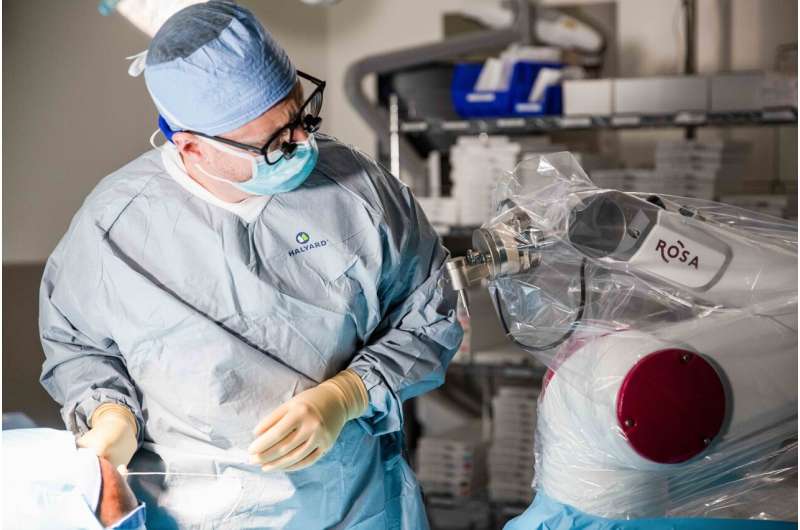This article has been reviewed according to Science X's editorial process and policies. Editors have highlighted the following attributes while ensuring the content's credibility:
fact-checked
peer-reviewed publication
trusted source
proofread
Researchers use pioneering new method to unlock brain's noradrenaline system

An international team of researchers has provided valuable insights into the brain's noradrenaline (NA) system, which has been a longtime target for medications to treat attention deficit hyperactivity disorder, depression, and anxiety.
Equally important beyond the findings is the groundbreaking methodology that the researchers developed to record real-time chemical activity from standard clinical electrodes which are routinely implanted for epilepsy monitoring.
Published online in the journal Current Biology, the research not only provides new insights into the brain's chemistry, which could have implications for a wide array of medical conditions, it also highlights a remarkable new capacity to acquire data from the living human brain.
"Our group is describing the first 'fast' neurochemistry recorded by voltammetry from conscious humans," said Read Montague, co-corresponding and senior author of the study, the VTC Vernon Mountcastle research professor at Virginia Tech, and director of the Center for Human Neuroscience Research and the Human Neuroimaging Laboratory of the Fralin Biomedical Research Institute at VTC. "This is a big step forward and the methodological approach was implemented completely in humans—after more than 11 years of extensive development."
About the method
Voltammetry techniques for making real-time electrochemical readings in rodents and other laboratory models have yielded deep insights into brain function for about 30 years, but there was no clear path to use the techniques in humans, because they require electrodes to be inserted into the brain.
"Instead, we focused on what's already being used in patients for medical procedures," said Montague, who is also a professor in the Department of Physics at the Virginia Tech College of Science and in the Department of Psychiatry and Behavioral Medicine at the Virginia Tech Carilion School of Medicine. "When are surgeons already putting a wire in someone's brain? And could we design a method to piggyback on that?"
The team's initial approaches required the insertion of exclusive carbon-fiber electrodes designed at the Fralin Biomedical Research Institute into awake patients receiving deep brain stimulation surgery for Parkinson's disease or other disorders.
The research team has now demonstrated that electrochemistry can be performed with electrodes that are already in place and in standard clinical use, opening a window to never-before-seen brain activity.
About the noradrenaline system
The electrodes were in the amygdala, a brain region deeply intertwined with emotional processing and profoundly influenced by NA signals.
The NA system originates in a small midbrain nucleus known as the locus coeruleus (LC), and it has long been a focal point for developing medications aimed at addressing conditions like ADHD, depression, and anxiety.
"The LC-NA system is believed to regulate arousal and attention and is a pharmacological target in multiple clinical conditions, but our understanding of its role in health and disease has been impeded by a lack of direct recordings in humans," said co-corresponding and lead author Dan Bang, associate professor of clinical medicine and Lundbeck Foundation Fellow at Aarhus University, Denmark, and adjunct associate professor at the Fralin Biomedical Research Institute. "We addressed this problem."
In the study, three patients viewed neutral, checkerboard images mixed with emotionally charged images from the International Affective Pictures Database, shedding light on how the NA system responds to various emotional states.
As expected, NA levels correlated with emotional intensity, particularly during encounters with unexpected images, underscoring the NA system's significance in conditions like ADHD.
"This is groundbreaking work that represents a significant technical advance in our ability to understand human brain activity," said Wael Asaad, director of Functional and Epilepsy Neurosurgery at Rhode Island Hospital and vice chair for research in the Department of Neurosurgery at Brown University, who was not involved in the research.
"While it has been possible to record electrical brain activity in humans in a variety of settings for many years, this gives us only half the picture. How those neurons communicate with neurotransmitters in real-time, at short-timescales, has generally been much more difficult to study," Asaad said. "In addition to the scientific value of this study, the techniques it demonstrates will be of tremendous value for a broad range of studies. It represents a milestone in our efforts to understand the functions of human brain circuits."
In previous studies, the group was the first to observe sub-second variations in brain chemicals in awake human subjects in a 2011 study. The scientists later discovered how dopamine and serotonin jointly underpin human decision-making and sensory processing in a series of publications in 2016, 2018, and 2020 by using specially designed electrodes inserted during deep brain stimulation surgery.
More information: Noradrenaline tracks emotional modulation of attention in human amygdala, Current Biology (2023). DOI: 10.1016/j.cub.2023.09.074. www.cell.com/current-biology/f … 0960-9822(23)01355-6

















